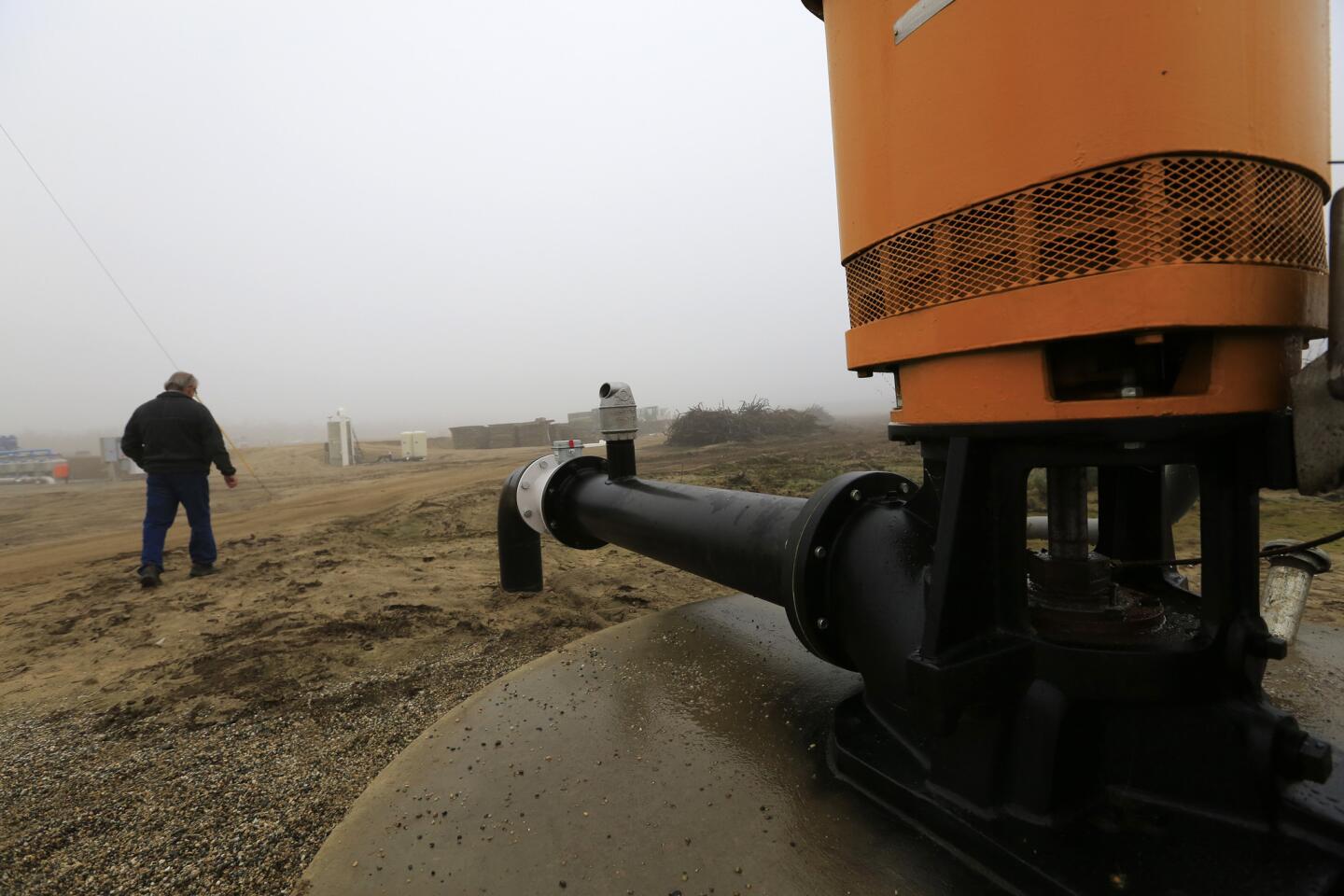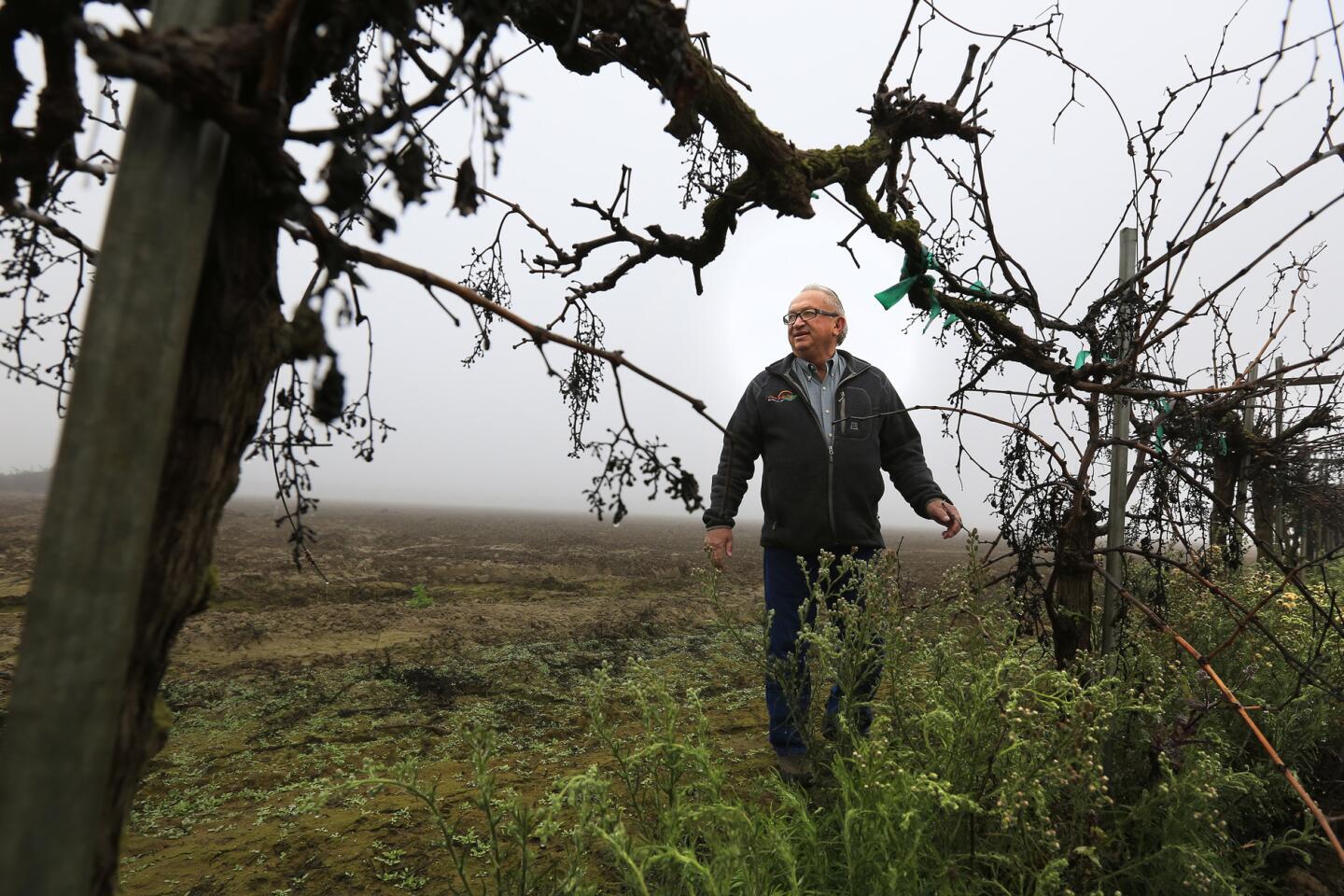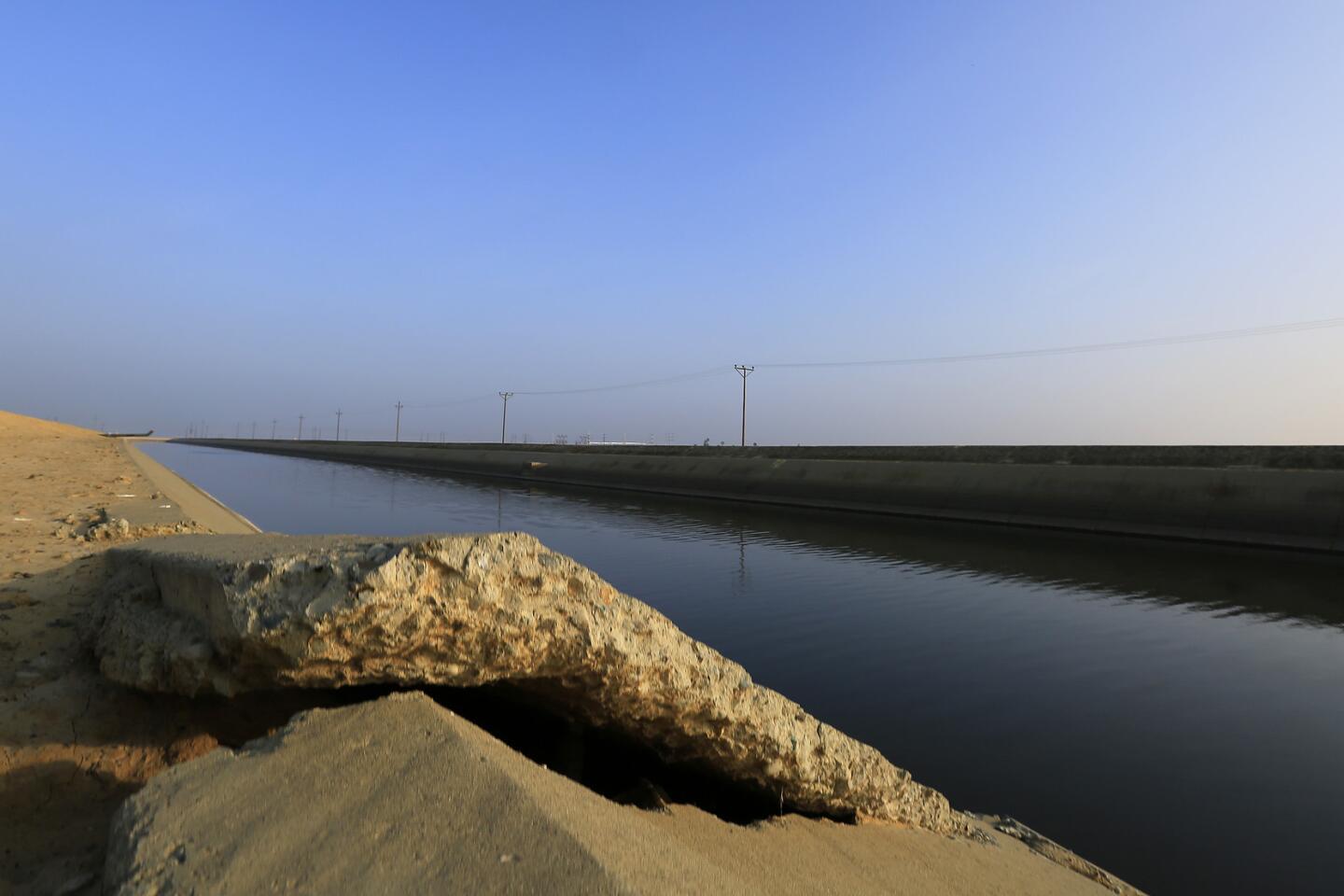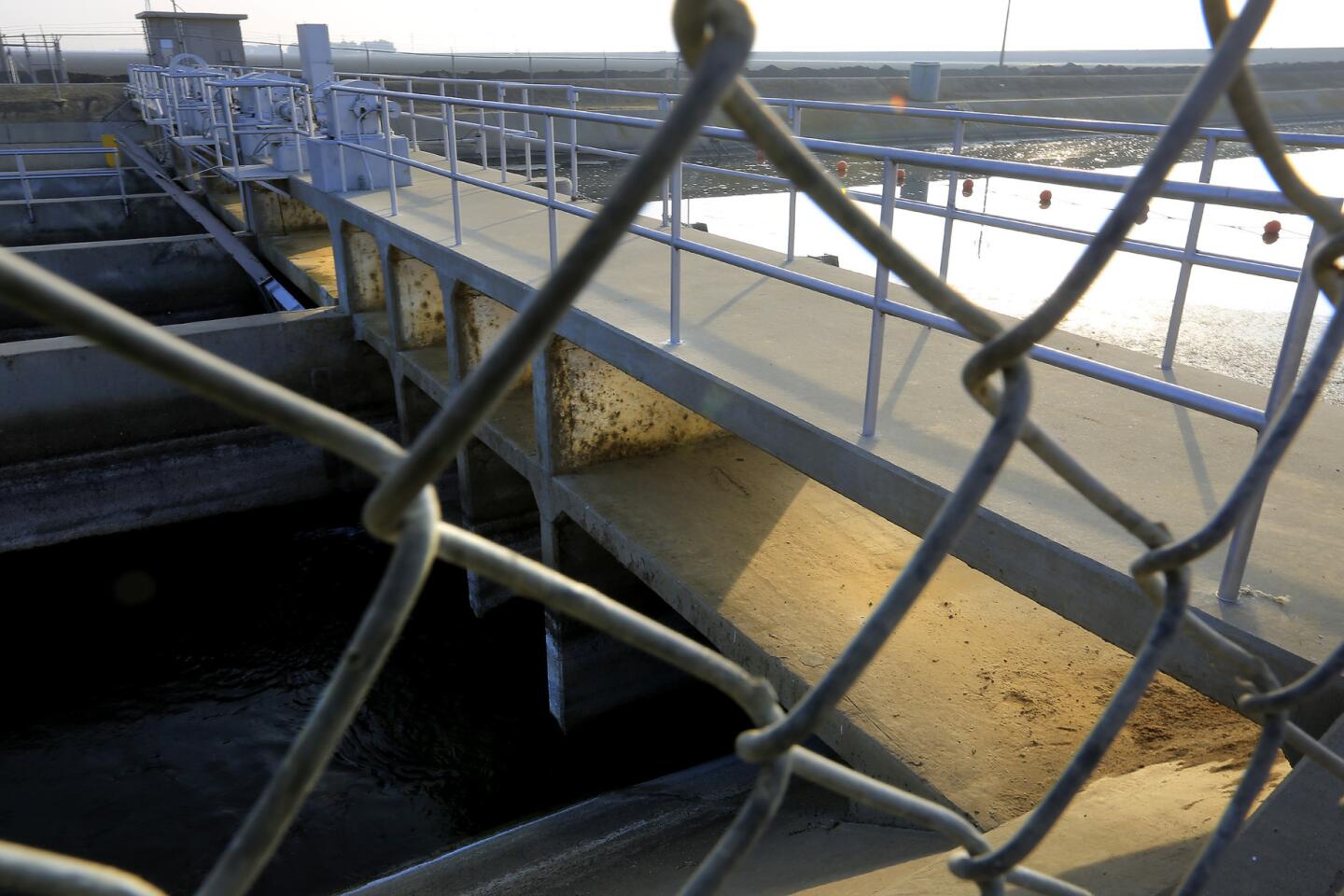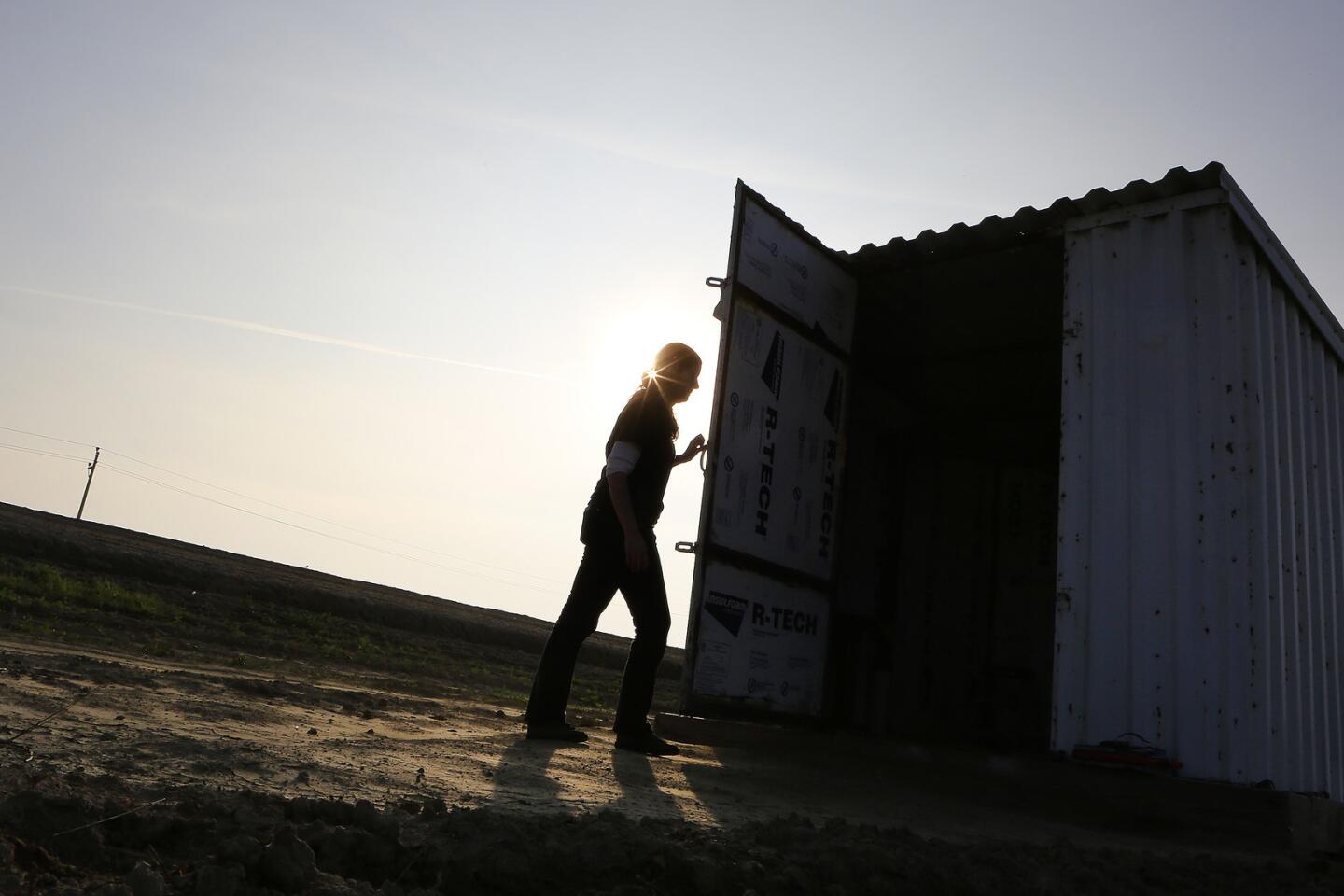Overpumping of Central Valley groundwater creating a crisis, experts say
- Share via
El NIDO, Calif. — A simple instrument with a weight and a pulley confirmed what hydrologist Michelle Sneed had suspected after seeing more and more dirt vanish from the base of her equipment each time she returned to her research site last summer. The tawny San Joaquin Valley earth was sinking a half-inch each month.
The reason was no mystery. “There are wells up and down this road,” Sneed said, nodding toward a two-lane byway that cut across the flat agricultural landscape.
Parts of the San Joaquin Valley are deflating like a tire with a slow leak as growers pull more and more water from the ground. The land subsidence is cracking irrigation canals, buckling roads and permanently depleting storage space in the vast aquifer that underlies California’s heartland.
The overpumping has escalated during the past drought-plagued decade, driving groundwater levels to historic lows in some places. But in a large swath of the valley, growers have been sucking more water from its sands and clays than nature or man puts back for going on a century.
They are eroding their buffer against future droughts and hastening the day, experts warn, when they will be forced to let more than a million acres of cropland turn to dust because they have exhausted their supplies of readily available groundwater.
“It’s like a bank account. If the money you put in is less than what you’re taking out, it’s a deficit. How long can you withstand that?” asked supervisory hydrologist Claudia Faunt, who is Sneed’s boss at the U.S. Geological Survey.
The Central Valley aquifer extends for about 400 miles under the Sacramento and San Joaquin valleys. The subterranean water, some of which seeped into the ground 10,000 to 20,000 years ago, is California’s biggest reservoir. Yet it has been largely unregulated and unmonitored. Most of the more than 100,000 wells that pierce the valley floor are unmetered and landowners have taken what they wanted.
Scientists estimate that since the first wells were drilled by settlers more than a century ago, pumping has depleted Central Valley groundwater reserves by 125 million acre-feet. That is about 4 1/2 times the capacity of Lake Mead, the biggest surface reservoir in the country. About 20 million acre-feet of that loss occurred in the last decade.
Until last year, California didn’t have a statewide groundwater law, making it an outlier in the West. The legislation, intended to end unsustainable groundwater use, won’t do that any time soon. Agricultural interests opposed the regulations, which call for the creation of local groundwater agencies that have more than two decades to fully comply.
In the meantime, it’s easier for growers to keep pumping than rein in their use. “Telling people they have to stop irrigating is a huge economic thing,” said Charles Burt, chairman of the Irrigation Training and Research Center at Cal Poly San Luis Obispo. “Guys are going to get their guns out. If you were farming, you wouldn’t take that very lightly.”
When Burt compares the annual groundwater overdraft in the valley with crop water usage, he figures that 1 million to 1.5 million acres will go out of production in coming years. “There are just more straws in there than there is water,” he said. “It’s been going on for a long time.”
The Delta-Mendota Canal lies a stone’s throw from Sneed’s research site. After checking a monitoring well and subsidence instrument in January, she drove her white government Jeep along the aqueduct, which carries federal irrigation deliveries south from the Sacramento-San Joaquin River Delta.
She parked and walked to a point where the side of the canal had buckled, pushing two pieces of cracked concrete up into a shallow “V.” Not far away was another break. Caused by uneven subsidence, the buckling creates holes in the canal bed, which slows down water movement and ultimately reduces the aqueduct’s capacity.
Down the road, a small bridge over another agricultural canal has sunk so much it has to be demolished and replaced with a higher structure.
A 30-minute drive to the northeast, near El Nido, the land in the last few years has been sinking at the staggering rate of a foot a year. And the subsidence has little to do with drought.
“There are tons of young almonds and pistachios, and they have to pump,” Sneed said, referring to new nut orchards planted in areas that don’t have good access to surface water. “The problem is not going away,” she added.
Sneed started studying land subsidence at Cal State Sacramento in the 1990s, and there is no place she would rather do research than the San Joaquin Valley. “This has been some of the most fun work I’ve ever done,” she said.
A sinking feeling is not new to the valley. By 1970 half of it — an area greater than Los Angeles and Orange counties combined — had dropped more than a foot, according to pioneering research by USGS geologist Joseph Poland.
The greatest subsidence related to groundwater extraction ever recorded in the U.S. is on the valley’s west side, where the water table plunged 400 feet in the early and mid-20th century. The accompanying soil compaction caused an area southwest of Mendota to sink more than 28 feet. In a now famous 1977 photo, Poland stood by a telephone pole affixed with signs far above his head indicating where the ground had been in 1955 and 1925.
The subsidence largely stopped and groundwater levels rebounded in many areas after the arrival of federal and state irrigation deliveries, which provided growers with cheaper, better water.
But even when the water table recovers, subsided basins can’t hold as much water as they did previously. Soil compaction can permanently reduce the pore space between clay particles, leaving less room for groundwater.
In the long run, Sneed said, the loss of aquifer storage space is more troubling than buckling infrastructure.
“Infrastructure can be fixed. The storage capacity cannot,” she said.
Another new area of subsidence has emerged to the south of El Nido in part of the Tulare Basin, which is the epicenter of chronic overpumping. There, “groundwater is being mined,” Faunt and other scientists wrote in a 2012 research paper.
On the edge of the new bowl, Tipton grower Charlie Pitigliano, 65, has watched the local groundwater table plunge 150 feet in the last 15 years. He blames the drop on pumping spurred by stubborn drought, a rise in the acreage of thirsty permanent crops and environmental restrictions that have diminished federal irrigation deliveries.
“I’ve been doing this for 40 years. I felt if your well is not pumping, you just drill another hole,” he said. But he knows that can’t go on forever.
Pitigliano’s maternal grandfather was an Italian immigrant who bought farmland in the area in the 1920s. He mostly irrigated his crops with well water until the 1950s, when the federal Friant-Kern Canal came through with its bounty of San Joaquin River supplies.
Pitigliano started growing alfalfa, wheat and corn on some of that land in the 1970s, using groundwater and federal supplies. But he struggled financially, only surviving because he managed other people’s farmland. “You need to grow some almonds,” an uncle advised him.
He planted his first trees in 1988. Today, the roughly 1,500 acres that Pitigliano and his three sons own are lined with almond and pistachio trees, as is about half the acreage they manage for other landowners. Their clients used to be mostly neighbors. Now they are doctors and hedge funds.
Buoyed by global demand, almonds have become one of California’s most lucrative crops, worth more than $4.5 billion in 2012, according to the most recent U.S. Department of Agriculture figures.
But the nut boom sweeping the San Joaquin Valley is driving up water demand during droughts. Not only are almond trees thirstier than many annual row crops, they can’t be fallowed when water supplies are tight.
Pitigliano spent $1.5 million in the last two years drilling six new wells, some of which reach 1,000 feet beneath the valley floor, more than twice as deep as his old wells. The groundwater is carrying his family operation through one of the worst droughts in the state record. But it is alkaline and contains more crop-damaging mineral salts than supplies from his old wells. So he had to install a $50,000 treatment system.
“The cheap water is gone,” Pitigliano said as he sat in his farm office on a day when the valley fog draped his dormant orchards in a ghostly gray. The greeting on his office door proclaims, “Growing peace of mind since 1975,” but Pitigliano says if it weren’t for his children, he’d stake a “For Sale” sign in front of his property.
It is the economics of having to go deeper and deeper for groundwater that will ultimately force growers to retire land. It’s not that the Central Valley’s thick aquifer will run dry. Scientists estimate that it holds roughly 800 million acre-feet of water that seeped deep into the valley’s sands and clays over millenniums from streams and rivers swollen with runoff from the neighboring Sierra Nevada and coastal ranges.
Farmers will instead run out of water they can afford to pump. As the groundwater table drops ever lower, wells become prohibitively expensive to drill, water quality deteriorates and it takes more energy, and thus money, to pull supplies from depths of 2,000 feet or more.
Growers know the pumping levels aren’t sustainable, said Jim Sullins, the UC Cooperative Extension director in Tulare and Kings counties.
Many agree that something needs to be done, but they view the new state regulations with dread. “We’re getting to the point now, it’s going to be winners and losers,” he added.
Pitigliano is on a steering committee that could wind up deciding which water users lose in his corner of the valley.
The group will develop a plan to locally implement the state’s new groundwater law — most likely by a combination of recharging the aquifer and imposing limits on withdrawals.
If locals don’t, the state will eventually step in. And that is something most farmers desperately want to avoid.
“To save our valley, we have to police ourselves,” Pitigliano said, acknowledging that it won’t be easy.
“Who is going to say, ‘Turn your pump off?’ ”
Twitter: @boxall
More to Read
Sign up for Essential California
The most important California stories and recommendations in your inbox every morning.
You may occasionally receive promotional content from the Los Angeles Times.
